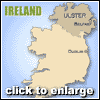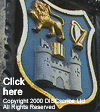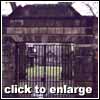
|
Part Six: The Covenanter Ships "Eaglewing", "Crown" and "Henry & Francis" By Brian Orr Have a question? Click Here to go to Brian's own Discussion Board!
The Scots had tried hard to fit in at the start but friction was continuing in Scotland with resentment to the religious policies of James I (James VI of Scotland) and his successor Charles I . There was also the fervour of evangelical groups, especially the Covenanters, that added friction to the Presbyterian communities in both Scotland and Ulster. The thoughts of a few turned to the possiblity of joining the exodus to Massachusetts, but whether the impetus came from Scotland - where as early as 1630 there had been discussions - or from Ulster is uncertain . A group of Planters and the Presbyterian minister John Livingston agreed in 1634 to seek information from the Massachussetts settlers about the prospect of acquiring land and the freedoms they desired. Letters were sent to John Winthrop, the governor and seemingly encouraging replies were received as some Planter families prepared to emigrate. "Eaglewing"
The building of the ship got under way at the small village of Groomsport on the shore of Belfast Lough and it was not until the autumn of 1636 before it was ready. At 150 tons the "Eaglewing" was barely big enough for the 140 passengers who had gathered together to face the dangers of the seas in this small craft. Although stoutly built, the "Eaglewing" was untried in the rough seas that it was to encounter following its departure from Carrickfergus on September 9, 1636. Difficult winds drove the ship into Loch Ryan almost before it had cleared the harbour but at length they set sail once more. John Livingston, minister at Killinchy, who had been at the heart of the emigration plans, was to say afterwards that the ship was three or four hundred leagues from Ireland when it was hit by turbulent seas and a hurricane that broke the ships rudder: heavy seas broke over the vessel and poured down into the cabins and the hold. The rudder was repaired but the ministers and the passengers aboard held a meeting and concluded that it was God's will that they should return to Ireland. On November 3, the ship arrived back in Belfast Lough.
The Scottish passengers returned home and the Ulster Scots having previously sold their possessions, sought with difficulty to pick up the threads of their former life. There was no further attempt to make the trip to New England. The embarrassment of failure was felt by the ministers no doubt and they were subject of some scathing criticism - "their faith not being answerable to their zeal" as the Bishop of Derry wrote to the arch persecutor Archbishop Laud.
The failure of the expedition also meant that these strong willed Scots were able to bring their influence to bear in subsequent events in Scotland. Amongst these were John Livingston, and Robert Blair, a minister of Calvinist leanings at Bangor,who was responsible for a revival of the Presbyterian church in County Antrim and County Down.. They and others, such as Robert Cunningham minister of Holywood, fled to Scotland to escape the persecution of Strafford. It meant that these staunch supporters of Presbyterianism were present to add their respected voices to the National Covenant of 1638.
In Scotland there was increasing dissent and Covenanting fervour was bloodily persecuted for another 50 years but especially in "The Killing Time" from 1679 - 1689. The second of the Covenanting ships in this tale to set out with Covenanters aboard was the "Crown" Following the Battle of Bothwell Brig on June 22, 1679, some 1200 prisoners were taken and incarcerated in a make shift, open air prison next to the Greyfriars Kirk in Edinburgh. Of these prisoners, 257 erstwhile ringleaders and ministers were sentenced to be transported to the West Indies or Virginia as white slaves.
The vessel set sail on November 27, 1679, but within days was forced by bad weather into the Orkney port of Deersound where despite local advice, she set out once more into the deep swells of the Atlantic Ocean. The ship had hardly cleared land when she struck rocks off of Deerness and was wrecked. It is said that the captain was a heartless and cruel man and despite the pleas of the frightened prisoners he ordered the hatches to be chained. Thus it was on December 10, 1679, that 211 Covenanters went to a watery grave. The crew escaped by cutting down a mast and using it as a bridge to the shore but prisoners who tried to do the same were forced back into the foaming sea. A mere 46 Covenanters survived the wreck only to be transported later.
A magnificent granite memorial stands at Deerness commemorating the sad event.
There were other emigrants who were required to pay £5 passage money but they could alternatively be indentured servants for four years after which they would receive 25 acres of land. The ship set sail on September 5, 1685, from Leith and made landfall at Perth Amboy, New Jersey, in December. It was a traumatic journey with the ship suffering leaks, shortages of food and water, as well as fever. Of the 125 that set out some 31 of their number died, including Scott and his wife. During the voyage, Scott's son-in-law (named Johnstone) had urged the prisoners to accept a four year servitude so that the costs of the venture could be recovered, which the prisoners resisted. The ship's master wanted to sail for Jamacia or Virginia since a better price would be obtained in either place for the prisoners. Perhaps it was Divine Providence intervening for these Covenanters, but a change of wind forced the ship into New Jersey as originally planned.
Meet the Author, Brian Orr, Researcher with The Guild of One Name Studies
Back to The Covenanters, Main Page
Part One: The Covenanters: Who Were They?
Covenanters Time Line
|
Thursday, December 26th, 2019
Attention visitors: Tartans.com is back. Please note that this is a snapshot of the site as it existed nearly 20 years ago and you may encounter broken links; we are still combing through the site and correcting those as we find them. Please also note that some sections are currently not functional, primarily the discussion forums/clan chat boards.
|
** HOME - First Time Visitors - Glossary - - Contact Us ** Awards | Bibliography | Clan Calendar | Clan Chat | Clan Finder | History | Famous Scots | Genealogy | Great Hall of the Clans | Links | News and Features | Scots on the Net | Search | Site Map The Gathering of the Clans
Copyright 1995- Tartans.com - All Rights Reserved. |




